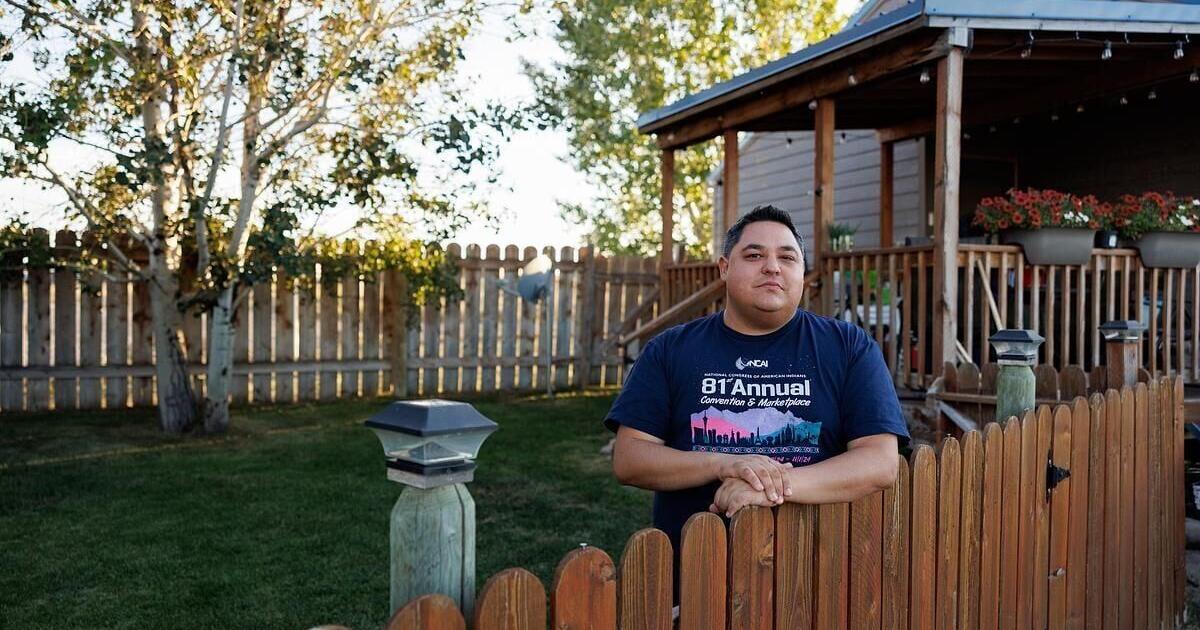
BLACKFEET RESERVATION — After a busy day registering students at Blackfeet Community College, President Brad Hall drove two miles to his house and changed into more comfortable clothes. He lit the grill on his porch and put vegetable-and-steak kabobs on the grates. The food sizzled as he set the table for dinner with his father, Ted.
For Hall, 40, homeownership on the reservation was never a guarantee. There’s a severe housing shortage in tribal communities nationwide, and reservation residents face daunting barriers to buying and building homes. The Native American homeownership rate is significantly lower than the national average. In Montana, the rate of Native American homeownership is 48.8% — about 21 percentage points below that of their White neighbors.
A long-standing housing shortage on reservations is reinforcing cycles of poverty by forcing young residents to seek opportunities far from home and by discouraging financially secure citizens from returning home.
Against those odds, though, Hall closed on his two-bedroom house in Browning in April 2024.
“It’s pretty perfect,” he said. Living so close to the college means Hall can get to campus quickly to support his faculty and students.
“I think living in the context you’re working in is really important,” he said. “It’s a grounding factor.”
Ever since Hall left the reservation in 2019 to work as a tribal outreach specialist at the University of Montana in Missoula, he said, he’d “felt a special urgency to come back to my home.”
Nestled beneath the Rocky Mountain Front in northwest Montana, the Blackfeet Reservation is home to more than 10,000 people.
“This is where I wanted to make the impact,” he said.
Hall jumped at the opportunity when he saw the president’s position come open at Blackfeet Community College, which serves about 435 students each year and employs nearly 100 people. He got the job in 2022. The first challenge was finding a place to live.
Hall’s path to homeownership wasn’t easy, but his experience offers insight into what’s possible when adequate housing is available to reservation residents.
“Having access to housing actually makes a community thrive,” said Jeff Ackley, of Enterprise Community Partners, a nonprofit that promotes affordable housing nationwide. “Because without stable, safe and secure housing, everything else falls apart.”
A path home
For his first two years as president of BCC, Hall lived in two different rental units in East Glacier Park Village, a small community on the western edge of the reservation near Glacier National Park. The tourist trade inflates local rates, and Hall said he paid between $1,100 and $1,300 per month in rent. The median rent on the Blackfeet Reservation is $492.
In 2023, Hall turned to NACDC Financial Services on the Blackfeet Reservation.
Because the federal government holds the title to trust land — which accounts for most reservation land in Montana — commercial banks are unable to repossess property if a homeowner defaults. That can make it difficult for prospective homebuyers like Hall to secure a traditional mortgage. Unlike banks, many Native American Community Development Financial Institutions like NACDC are set up as nonprofits, and so can be more flexible in helping Indigenous borrowers access financing. Executive Director Angie Main said NACDC can accept “a lot of things that a bank won’t” as collateral for a loan.
“We can take anything with a serial number, like computers, laptops, anything,” she said, adding that the organization has had a 0% default rate since it started lending in 2011.
Where a bank might turn an applicant down for poor credit, NACDC offers credit-building loans to help borrowers pay off debt. The organization also provides education tools like a first-time-homebuyer class and one-on-one counseling, and allows borrowers to hold a credit-builder loan at the same time as a home loan. And where commercial banks might direct individual applicants to work with the Bureau of Indian Affairs to get a lease or mortgage approved, a process that can be easily bogged down in bureaucracy, NACDC has an established working relationship with the agency.
“When people say it’s impossible to lend on trust land, we just have to laugh,” said NACDC loan administrator Patty Gobert. “It just takes time. It just takes patience. But we get it done.”
Main said NACDC and the dozens of other Native CDFIs nationwide succeed because they can tailor their services to meet complex community needs.
“We grew up in these communities,” she said. “We’re from these communities. We understand the needs in these communities. We understand how politics work. We understand how tribal court systems work.”
While NACDC has seen success — closing 109 real estate loans across Montana for more than $11 million since 2017 — Main said the organization doesn’t have enough money to fulfill its mission of providing financing opportunities at scale.
Native CDFI offices are primarily funded through the federal government, and Main fundraises to earn additional money to loan and to staff the office, but it’s still not enough. In 2023, Main said, NACDC had to put a moratorium on new home loans because the organization didn’t have enough money. And while a lot of people could benefit from NACDC’s services, many in the community aren’t familiar with the organization. Main said she purposely does not advertise the organization’s services, because she doesn’t always have enough capital to support new customers.
“As soon as we get it, it’s gone,” she said.
When NACDC pre-approved Hall for a home loan, Hall said, the uncertain work of finding a house for sale on a reservation with a chronic housing shortage began. The 2019-2023 American Community Survey reported a homeowner vacancy rate of functionally zero on the Blackfeet Reservation, meaning there were no homes for sale when the survey was conducted.
Hall ultimately learned of a home for sale through word of mouth. With NACDC’s help, he closed the purchase in spring 2024.
“It was pure luck,” he said. “There’s no other way to describe it, because homes are not always available here.”
Hall is proud to be a homeowner. He plans to eventually build a garage and add more bedrooms. But even more than enjoying the security and opportunities of his personal space, Hall said owning a home on the reservation allows him “to really optimize my ability to serve my community.”
“It’s changed me,” he said. “I didn’t really have a stake in any of the places that I was in before. … But this is my forever home, a home that my family will always have to come back here.”
When adequate housing is available to those who need it, tribal leaders say, entire communities can transform.
“What gets derived from a whole group of people feeling like they just belong, or that they’re valued, that there’s dignity in their existence, that their neighbors care about them, that they care about their neighbors, that if they felt like they needed something, somebody would be there to support them, I think that does a lot for the collective well-being of a group,” said Caroline LaPorte — an attorney with Indian Law Resource Center.
Native CDFIs have a proven track record in Indian Country. A 2018 pilot program provided additional capital to two Native CDFIs in South Dakota, allowing them to issue loans for the purchase or development of housing in Indian Country. The two organizations loaned about $2 million to eligible Native homebuyers in North Dakota and South Dakota. Over the course of a single year the CDFIs doubled the number of home loans a comparable federal program had provided on two South Dakota reservations in the previous decade, according to the Native CDFI Network.
But lack of capital still thwarts the scalability of that success.
The solution to chronic housing shortages, Main said, is “a huge investment.”
“Give me $25 million and we’ll get a piece of land, we’ll work with the land, we’ll work with the tribe, we’ll work with the Bureau of Indian Affairs, and we can get this done,” she said. “But there’s nobody right now saying, ‘OK, I want to invest $25 million on the Blackfeet Reservation in housing. Can I work with you guys?’”
Native CDFIs are primarily funded through the Native American CDFI Assistance Program (NACA), a federal initiative that grants competitive awards to organizations nationwide. But NACA funding, CDFI leaders say, is inadequate to meet community needs. There are 64 certified Native CDFIs nationwide, and the total NACA appropriation for 2025 was $28 million. The Native CDFI Network, an advocacy organization, has urged Congress to fund the NACA program at $50 million for fiscal year 2026. Securing federal funding each year requires extensive relationship-building and congressional outreach, said Native CDFI Network Chairperson and CEO Pete Upton.
“We’ve really had to educate congressional staff and agencies that Natives are not part of the [Diversity, Equity and Inclusion] bucket,” Upton said. “The federal government has a responsibility to Native communities, not only through the Constitution but through laws and treaties. We continually educate the staff — and there’s a huge turnover in staff within congressional offices and within the Treasury. We constantly re-educate them on how Native communities are a little bit different.”
Upton said the U.S. House Appropriations Committee recently released a draft fiscal year 2026 Financial Services and General Government bill that proposes a $35 million allocation for the NACA program — short of the $50 million ask, but a significant increase from the year prior.
But to make a real dent in Indian Country’s housing crisis, Upton said, Native CDFIs would need an annual appropriation closer to $400 or $500 million.
“That would be a starting point,” he said. “That’s just based upon the need in Indian Country for housing.”
‘This is home’
On a cool August evening, Hall and his father sat down to eat kabobs on the deck outside Hall’s house, on land their ancestors have called home for more generations than they can count.
Zip, a black-and-white dog, sauntered up the porch steps and lay down near the table, waiting for scraps. Cars whizzed past on the road beyond Hall’s fenced yard. Neighborhood parents called children inside for dinner. Pink clouds hovered above the Rocky Mountain Front as the sun began to set.
“This is our homeland,” said Hall’s father, Ted, as he bit into a piece of steak. “This is where I like to be.”
“This is home,” Hall said. “There’s no replacement for home.”
The Shelter Gap was produced with support from the McGraw Center for Business Journalism at the Craig Newmark Graduate School of Journalism at the City University of New York. Lee Enterprises and Montana Free Press co-published the stories.
Love
0
Funny
0
Wow
0
Sad
0
Angry
0
Be the first to know
Get local news delivered to your inbox!
* I understand and agree that registration on or use of this site constitutes agreement to its user agreement and privacy policy.



